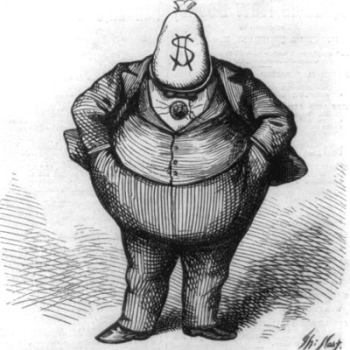Banks used to take more than $36 billion a year from their customers. They just took it. They did this by reaching into those customers’ accounts and removing the money $30 at a time. This was called “overdraft protection,” and the banks pretended it was a service for those customers.
That practice has been reined in somewhat with new rules requiring banks to describe these “overdraft protection” charges more accurately and to convince their customers to allow them to take this money from them. As Eric Dash reports in The New York Times, that’s meant a loss of about $12 billion a year for the banks.
The flipside of that “loss” or “cost” for the banks, of course, has been a gain of about $12 billion a year for those banks’ customers. Well, not a gain, exactly, but the chance to keep a bit more of their own money in the bank accounts they set up for the purpose of keeping that money instead of watching those balances reduced $30 at a time by the banks reaching into them and taking out billions of dollars of money. When the balance in some customers’ bank account gets down to the last $15, at least now it doesn’t suddenly become -$15. Having only $15 in one’s bank account isn’t great, but it’s better than having -$15 — particularly when that -$15 will turn into -$45 tomorrow and -$75 the next day. (To the cumulative tune, again, of more than $36 billion a year.)
But as Dash reports, the banks are looking to recoup their “losses” by creating new excuses to reach into their customers’ accounts and take those customers’ money:
Banks can still earn a profit on most checking accounts. But they are under intense pressure to make up an estimated $12 billion a year of income that vanished with the passage of rules curbing lucrative overdraft charges and lowering debit card swipe fees. In addition, with lending at anemic levels and interest rates close to zero, banks are struggling to find attractive places to lend or invest all the deposits they hold. That poses another $8 billion drag.
Put another way, banks would need to recoup, on average, between $15 and $20 a month from each depositor just to earn what they did in the past, according to an analysis of the interest rate and regulatory changes on checking accounts by Oliver Wyman, a financial consulting firm.
For consumers, the result is a quiet creep of new charges and higher fees for everything from cash withdrawals at ATMs to wire payments, paper statements and in some cases, even the overdraft charges that lawmakers hoped to ratchet down. What is more, banks are raising minimum account balances and adding other new requirements so that it is harder for customers to qualify for fee waivers.
Even the much-maligned debit usage charges have effectively been bundled into higher monthly fees on checking accounts. Bank of America abandoned its $5 a month debit card usage fee in late October amid a firestorm of criticism. Yet, it more quietly raised the cost of its basic MyAccess checking account by more than $3 a month earlier this year. Monthly maintenance fees now run $12 a month, up from $8.95.
Open a basic checking account in Bank of America with $100 in January and without spending a dime you’ll have a negative balance before Thanksgiving — assuming that BofA doesn’t create other new fees in the intervening months to remove those funds from the account even faster.
Banks were able to transfer more than $36 billion a year from us to them through the larcenous “overdraft protection” racket in part by stroking our egos. We Americans love nothing more than being told we’re above average — that we’re exceptionally virtuous and responsible people who are better than our neighbors. By indulging that vanity, banks were able to suppress much of the outrage that might otherwise have accompanied the annual theft of $36 billion. They got us to pretend that this was just something that happened to irresponsible people who irresponsibly failed to maintain large balances in their checking accounts.
But this new generation of myriad fees and fee-hikes designed to recoup that same $36 billion a year can’t be as easily dismissed as being a useful expression of disapproval of the irresponsible, immoral, undeserving poor. These hit everyone indiscriminately, and even the most financially responsible and insufferably self-righteous won’t be able to pretend that these are excusable or justifiable or anything other than flimsy pretexts for the banks reaching into private accounts and withdrawing money simply because that money is there and they want it.
These new fees, then, may be the last straw for many previously complacent and compliant bank customers. The big banks’ new brazenness has finally pushed many of those customers too far, and the new conversation arising thanks to the “barbaric yawp” of Occupy Wall Street is making more and more of those customers aware that there are options.
Those options aren’t new. It’s the age-old American story: George Bailey vs. Old Man Potter. And it pleases me to see that struggle being framed in exactly those Capraesque terms:
That’s a video for the Move Your Money Project, which urges Americans to “Invest in Main Street, Not Wall Street” — to put their money to work for the good of Bedford Falls instead of Potterville.
That effort — spurred by the social-media driven promotion of Nov. 5 as “Bank Transfer Day” — has so far led more than 650,000 Americans to move their money into credit unions. More Americans opened credit union accounts last month than did so in all of 2010. That amounted to some $4.5 billion now available for housing and auto loans and investment in small businesses instead of being gambled on the securitized futures of securitized futures of securitized futures. That’s $4.5 billion of our money that won’t be siphoned away $30 or $12 or $8.95 at a time, but will instead be put to work creating real wealth in real communities.
That’s a good start.















